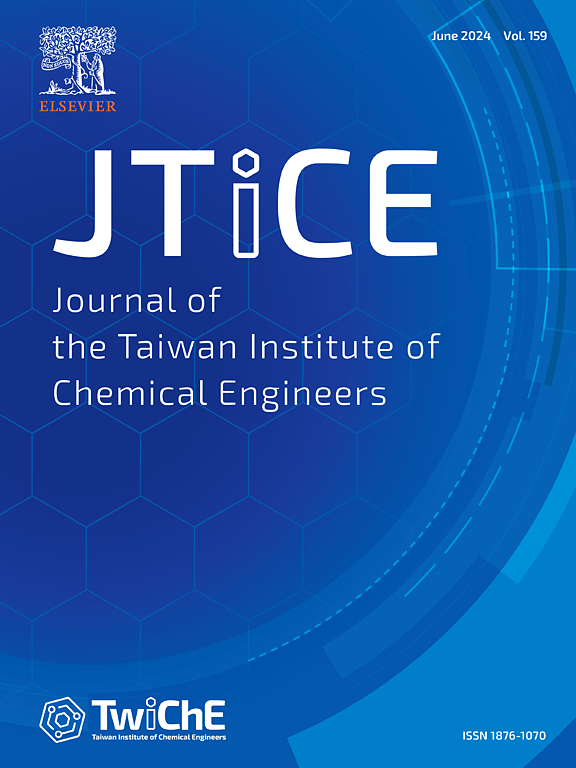Revisiting the softening and melting behavior of sinter under simulated blast furnace conditions: Part II – Characteristics of microstructure evolution and grain coarsening
IF 5.5
3区 工程技术
Q1 ENGINEERING, CHEMICAL
Journal of the Taiwan Institute of Chemical Engineers
Pub Date : 2025-03-12
DOI:10.1016/j.jtice.2025.106066
引用次数: 0
Abstract
Background
To enhance the mechanistic understanding of softening and melting (S&M) behaviors and their role in determining blast furnace (BF) permeability performance, studying macro- and microstructural evolution under high-fidelity yet not oversimplified BF environments is indispensable.
Methods
Building on Part I, this study establishes experimental conditions that faithfully reproduce BF environments. Leveraging these high-fidelity conditions, we investigate the macro- and microstructural evolution and grain size distribution of metallic Fe and FeO at five temperatures: 1150 °C, 1250 °C, 1330 °C, 1430 °C, and 1550 °C.
Significant findings
Key conclusions link microstructural evolution to softening, melting, and dripping behaviors. From 1150 °C to 1550 °C, Fe and FeO grains undergo significant coarsening, with Fe increasing from 0.5–6.0 µm to 3.5–15.0 µm and FeO from 0.7–6.17 µm to 2.1–9.7 µm by 1430 °C. A critical dripping threshold for FeO droplets (>9.5 µm) in sinter ore shows grain coarsening significantly affects dripping timing and behavior. Additionally, the high melting points of slag phases in sinter ore compared to pellets and lump ores limit FeO droplet formation, resulting in less pronounced dripping behavior. These findings emphasize the need to investigate grain coarsening to understand dripping mechanisms across various burden materials and the potential impact of grain size variations on permeability in conventional versus hydrogen-rich blast furnaces.

烧结矿在模拟高炉条件下的软化和熔化行为:第二部分-组织演变和晶粒粗化的特征
为了加强对软化和熔化行为的机理理解及其对高炉渗透性能的影响,研究高保真但不过于简化的高炉环境下的宏观和微观组织演变是必不可少的。方法在第一部分的基础上,建立了真实再现BF环境的实验条件。利用这些高保真条件,我们研究了金属Fe和FeO在1150°C, 1250°C, 1330°C, 1430°C和1550°C五个温度下的宏观和微观组织演变和晶粒尺寸分布。重要发现:关键结论将微观结构演变与软化、熔化和滴水行为联系起来。从1150℃到1550℃,Fe和FeO晶粒明显粗化,1430℃时Fe从0.5 ~ 6.0µm增加到3.5 ~ 15.0µm, FeO从0.7 ~ 6.17µm增加到2.1 ~ 9.7µm。烧结矿中FeO液滴的临界滴下阈值(>9.5µm)表明,晶粒粗化显著影响滴下时间和行为。此外,与球团矿和块状矿相比,烧结矿中渣相的高熔点限制了FeO液滴的形成,导致滴下行为不那么明显。这些发现强调了研究晶粒粗化的必要性,以了解不同炉料的滴漏机制,以及晶粒尺寸变化对传统高炉和富氢高炉渗透率的潜在影响。
本文章由计算机程序翻译,如有差异,请以英文原文为准。
求助全文
约1分钟内获得全文
求助全文
来源期刊
CiteScore
9.10
自引率
14.00%
发文量
362
审稿时长
35 days
期刊介绍:
Journal of the Taiwan Institute of Chemical Engineers (formerly known as Journal of the Chinese Institute of Chemical Engineers) publishes original works, from fundamental principles to practical applications, in the broad field of chemical engineering with special focus on three aspects: Chemical and Biomolecular Science and Technology, Energy and Environmental Science and Technology, and Materials Science and Technology. Authors should choose for their manuscript an appropriate aspect section and a few related classifications when submitting to the journal online.

 求助内容:
求助内容: 应助结果提醒方式:
应助结果提醒方式:


